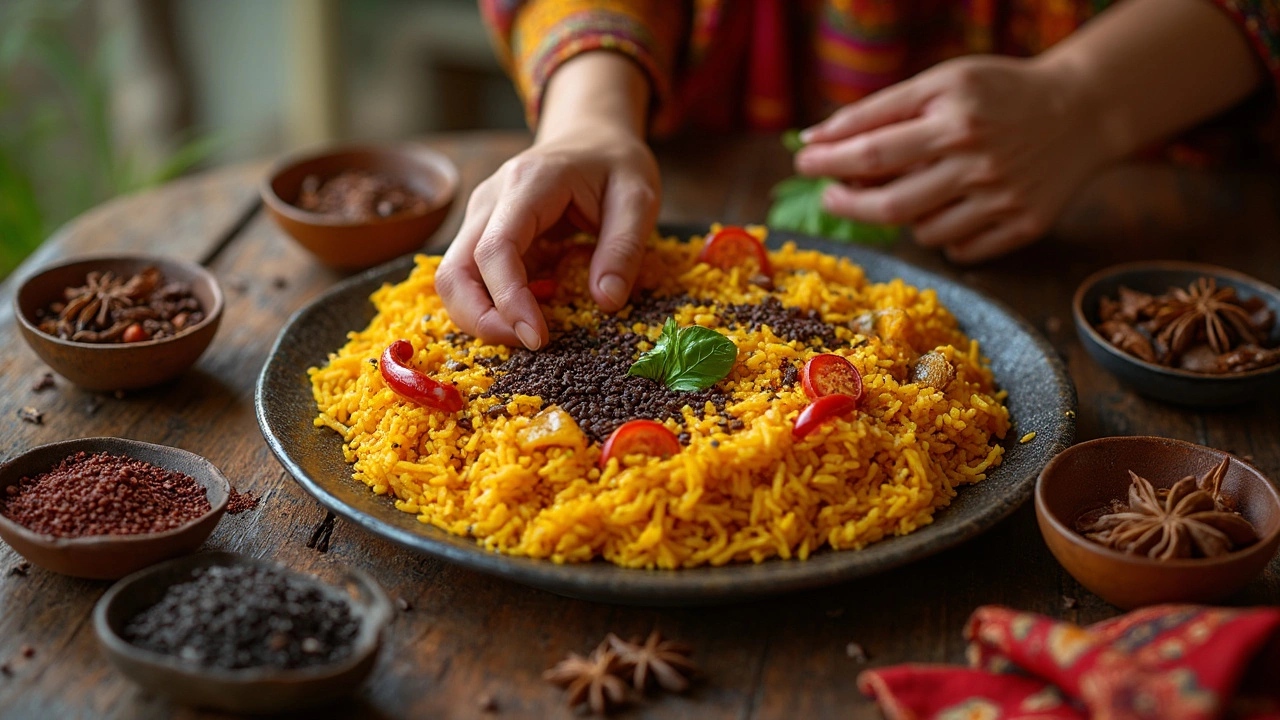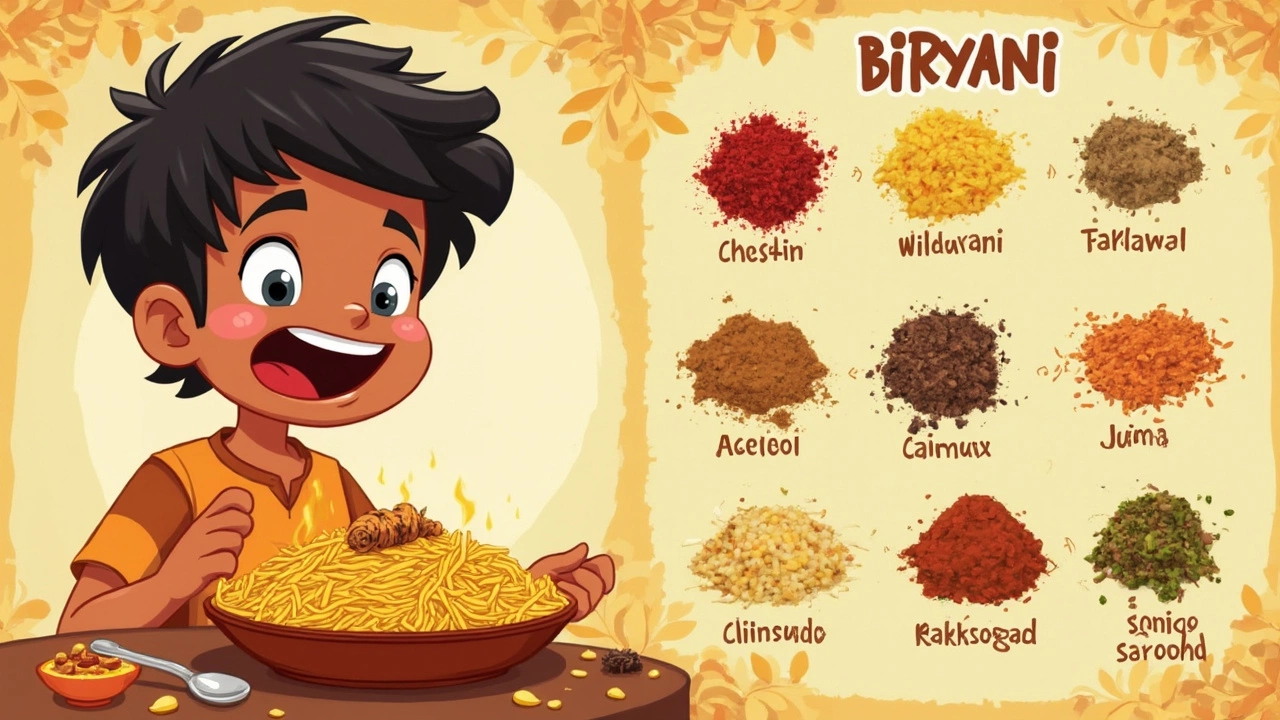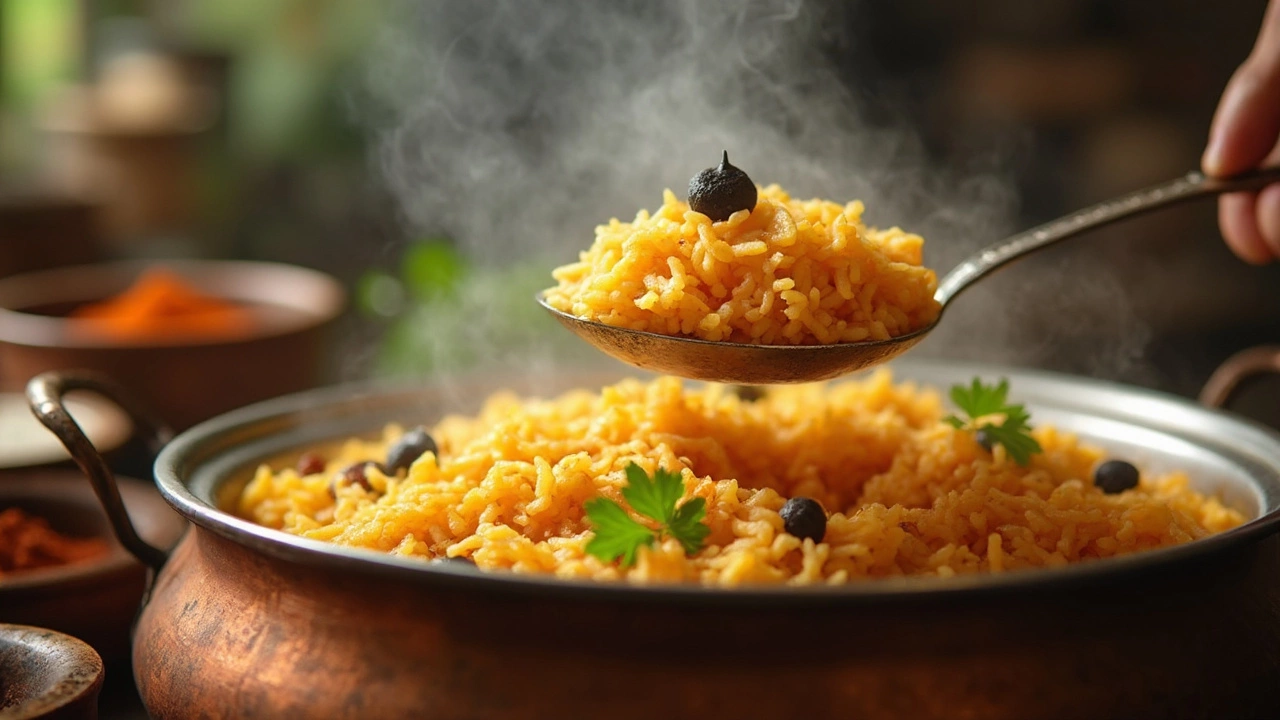You take a bite of biryani and suddenly your teeth crunch down on a hard, small black thing. Was that supposed to be there? Don’t worry, you’re not alone. Loads of people have asked about these black bits lurking among the rice and chicken. They’re not burnt rice or sneaky bugs. They’re actually whole spices, and they’ve got a serious job.
The most common culprit? Black cardamom or a black peppercorn. Sometimes it’s a clove, looking almost the same. These aren’t there just to surprise you—they’re the reason your biryani smells so good and tastes so rich. Whole spices release oils and aroma that ground stuff just can’t match. They’re like the secret weapon for deep, layered flavor in classic biryani.
- Spotting the Black Thing: What You’re Seeing
- Why It’s Added to Biryani: The Flavor Secret
- Types of Spices Used: Not Just One Black Thing
- Dealing with Whole Spices: To Eat or Not to Eat
- Smart Tips for Spice Lovers and Haters
Spotting the Black Thing: What You’re Seeing
If you ever paused in the middle of enjoying your biryani because you bit into a tiny, hard black thing, you’re basically experiencing the classic effect of whole spices. These bits are most often black peppercorns, cloves, or black cardamom pods. Sometimes, they’re even a stray bay leaf stem that’s turned dark during cooking.
Here’s a quick way to tell what you’ve stumbled on, because not everyone can simply eyeball their spices:
- Black Peppercorn: Tiny, perfectly round, and super-hard. If you chew it, expect a sharp, fiery jolt of spice.
- Clove: Smaller than cardamom, slightly pointy at one end, looks like a short nail. Gives off a warm, sweet smell if you press it.
- Black Cardamom Pod: Much bigger, oval-shaped, and kind of wrinkly. More smoky and earthy than heat-packed.
Don’t worry, none of these are mistakes. They’re put in on purpose. If you pick them out, you’re not the only one—lots of biryani regulars dodge them, especially the peppercorns.
| Name | Shape | Usual Size | Main Flavor |
|---|---|---|---|
| Black Peppercorn | Round | 4-6 mm | Pungent, spicy |
| Clove | Nail-shaped | 8-12 mm | Warm, sweet |
| Black Cardamom Pod | Oval, wrinkly | 2-3 cm | Smoky, earthy |
Next time you find that small black thing in your biryani, you’ll know exactly what you’re looking at. If you like hunting for flavor bombs, you might start looking for these on purpose. If not, just move them to the side of your plate—no biggie.
Why It’s Added to Biryani: The Flavor Secret
You might think the small black thing is just tossed in for looks, but it’s actually the backbone of what makes biryani unforgettable. Whole spices like black cardamom, peppercorns, and cloves infuse the rice and meat with an intense hit of aroma and taste. That depth you notice in a good biryani? You can thank these hard little flavor bombs for it.
So, why not just use powdered biryani spice instead? Whole spices do something ground mixes can’t: as biryani cooks, these spices slowly release their essential oils. They soak into the meat and rice, making every bite pop with a different layer of flavor. Powdered spices will just blend in and can even make the dish muddy or bitter if overused.
Cooks are usually picky about which spices go in, too. Here's a quick look at which spices are most common and what they bring to the table:
| Spice | Main Flavor Notes | Why It's Used in Biryani |
|---|---|---|
| Black Cardamom | Smoky, earthy, a hint of mint | Adds depth and warmth |
| Black Peppercorn | Sharp, hot, pungent | Kicks up heat and freshness |
| Cloves | Sweet, strong, slightly bitter | Sweetens and sharpens the overall aroma |
| Bay Leaf | Woodsy, herbal | Lays down a mellow undertone |
Good biryani is all about balance—enough spice to keep things interesting, but not so much that it’s overpowering. If you skip the whole spices, you’ll miss out on that signature biryani experience. That’s why even top cooks swear by adding these tiny black things, even if you end up picking them out at the table.
- If you want a milder spice hit, you can tie whole spices in a small piece of muslin cloth. Just fish it out at the end before serving.
- If strong spice surprises are not your thing, pick out the obvious bits before serving guests.

Types of Spices Used: Not Just One Black Thing
If you thought there’s just one mysterious "small black thing" in your biryani, think again. There’s actually a whole lineup of whole spices hiding in there, each with its own job. Indian cooks don’t just toss in anything for show—every spice adds something real to the dish.
Here are the usual suspects you’ll spot in a classic biryani:
- Black Cardamom (Badi Elaichi): Big, smoky, and not sweet like green cardamom. It’s bulky and has a rough outer layer. Used for its strong flavor in almost every Mughlai biryani.
- Black Peppercorns: Those tiny, round, hard balls are everywhere. They pack heat but don't dissolve in cooking, so you often bite them whole.
- Cloves: Small, nail-shaped, dark brown to black. Super aromatic and throw off a warm, almost sweet punch.
- Cinnamon Stick Pieces: Sometimes small chunks look black after cooking. Cinnamon gives a subtle woody sweetness.
- Bay Leaves: Not exactly black or small, but they often crumble and look dark in finished biryani. These leaves build depth in the spice mix.
Some other spices might show up based on region or family style—caraway seeds (shahi jeera), star anise, or even dried red chilies.
For a quick rundown, here’s a handy table showing the most common 'black things' and how they impact your biryani:
| Spice | Looks Like | Main Flavor | Often Found In |
|---|---|---|---|
| Black Cardamom | Large, wrinkly pod (about 2 cm) | Smoky, earthy | Mughlai, Hyderabadi biryani |
| Black Peppercorn | Small, round, hard | Peppery heat | All biryani types |
| Clove | Tiny nail-shaped, dark brown/black | Pungent, sweet-spicy | Mixed regional biryani |
| Cinnamon Piece | Small stick, sometimes darkened | Sweet, woody | Almost every biryani |
Don’t be surprised if you find more than one! Each plays a special part in making sure biryani isn’t just flavored rice—it’s a harmony of spice and aroma.
Dealing with Whole Spices: To Eat or Not to Eat
So, what do you do when you find that biryani has these hard black surprises? You’re not supposed to crunch through every spice you find. Most folks pick them out and set them aside while eating. That’s totally normal and actually expected at many tables across South Asia. Biting into a whole black cardamom or clove can give you a mouthful of strong, almost medicinal flavor, which isn’t for everyone—kids especially tend to spit them out straight away.
If you’ve ever wondered which whole spices might show up in your biryani, here’s a quick overview of what you might find and their “eat or avoid” status:
| Whole Spice | Common in Biryani? | Should You Eat It? |
|---|---|---|
| Black Cardamom | Yes | Better to Avoid |
| Clove | Yes | Up to You, but Intense! |
| Black Peppercorn | Very Common | Crunchy and Spicy—Most Avoid |
| Bay Leaf | Yes | Don’t Eat (Too Tough) |
| Cinnamon Stick | Yes | Don’t Eat |
Eating whole spices isn’t dangerous, but it can be a shock—and even cause a brief coughing fit if you bite down on something like black pepper by mistake. If you love strong spice hits, go ahead and try; just know it will be intense! For most people, it’s best to fish them out gently and leave them on the side of the plate.
One practical hack: if you’re serving kids or folks unfamiliar with these spices, you can pick some of the larger ones out before serving. Some cooks tie whole spices in a little piece of muslin (like a spice bag) before dropping them in the pot. This keeps the flavor but makes removal easy afterwards, so nobody ends up with a crunchy surprise mid-bite.

Smart Tips for Spice Lovers and Haters
No two biryani fans are the same—some love the punch of a whole spice, others want their meal smooth and surprise-free. So how do you handle those black cardamoms and peppercorns everyone finds in biryani?
- If you’re a spice lover: Don’t shy away! Munch on the whole spices if you want deep, bold bursts of flavor. Black cardamom can be smoky and intense, and biting down on a clove can trigger a sudden hit of warmth. Just be warned, it’s not subtle. Try keeping whole spices in your serving if you want that extra aroma—just remember, too many can be overpowering.
- If you’re a spice hater: Pick out the whole spices before eating. A quick poke through your rice with a fork makes a big difference. Some cooks also tie whole spices in a small piece of muslin cloth (a "potli") before adding to the biryani and remove it at the end—this gives you all the aroma but keeps your plate spice-free.
- Kids at the table? Removing whole spices before serving means less risk of them biting into a clove or cardamom and pulling faces. Lighter dishes or biryani for kids often use fewer whole spices for this reason.
- Can you use ground spices instead? Sure, but you’ll lose that punchy layered effect. A mix of ground and whole spices can keep things balanced. If you want a smooth biryani, go heavier on powders, lighter on the big stuff.
Here’s a straight-up comparison:
| Whole Spice | Flavor Impact | Easy to Remove? |
|---|---|---|
| Black Cardamom | Strong, smoky, earthy | Yes |
| Peppercorn | Peppery, spicy kick | Yes |
| Clove | Warm, slightly sweet | Yes |
| Bay Leaf | Subtle, herbal | Yes (but sometimes breaks) |
Bonus tip: If you’re ever hosting, ask guests if they mind whole spices in biryani. It only takes one person wincing after biting into a clove for everyone else to start digging through their rice. You’ll look like a thoughtful host and, honestly, the biryani will still taste amazing if you find the balance that works for your crowd.
